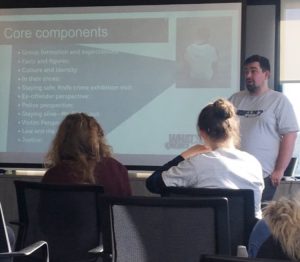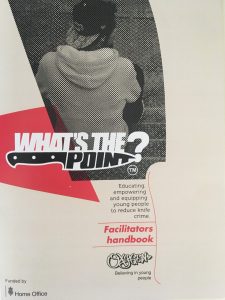The award-winning Kingston charity Oxygen drew its audience’s attention to the issue of knife crime at a Greenwich workshop on November 2 2018.
Oxygen said it recognised the importance of engaging with marginalised young people and that it aimed to alleviate the fears and pressures these young people experience.
Rory Densham Brown, head of youth work at Oxygen, said: ”Oxygen was set up by young people from local churches who were invested in trying to help the community, who recognised that there were areas of need.”
What’s the Point?
The “What’s the Point?” initiative – a preventative project that aims to change attitudes towards knife crime – reflects this youthful and community-oriented perspective. It aims to be accommodating of young people’s needs and the agenda of each of the sessions can be adapted.
Brown said the event in Greenwich was held to assist others in implementing the “What’s the Point?” project and training process within their own youth work organisations.

Various contributions to the discussion were made by other organisations, such as StreetDoctors and Fearless – an organisation that reports crime on behalf of those hesitant to speak to the police. Also speaking was an ex-offender who prompted a debate on ways of changing attitudes and improving responses to knife crime.
StreetDoctors offered medical input, sharing the story of a young man who was stabbed, who was able to apply his life-saving knowledge to instruct others. The involvement of StreetDoctors was an example of the way in which Oxygen successfully ”unlock[s] community based resources” to strengthen the impact of its project.

Statistics fail to paint a full picture
Oxygen recognises that statistics are based on reported crime which means they do not account for the crimes that are unreported, which is often the case with violent crime. Brown identifies the ”no snitch culture” as a particular obstacle in the way of young people communicating with the authorities.
Young people find themselves being pressured to lie about how they received their wounds when at the hospital to avoid questions and judgement.
Statistics will become increasingly accurate when young people are comfortable confiding in the authorities and reject the option of seeking retribution themselves.
The ‘in their shoes’ component of “What’s the Point?” requires participants to act out different scenarios and encourages them to think, highlighting the difference between an immediate reaction and an informed response.
Oxygen encapsulated the atmosphere of ”What’s the Point?” with the phrase “positive peer influence rather than negative peer pressure”.





